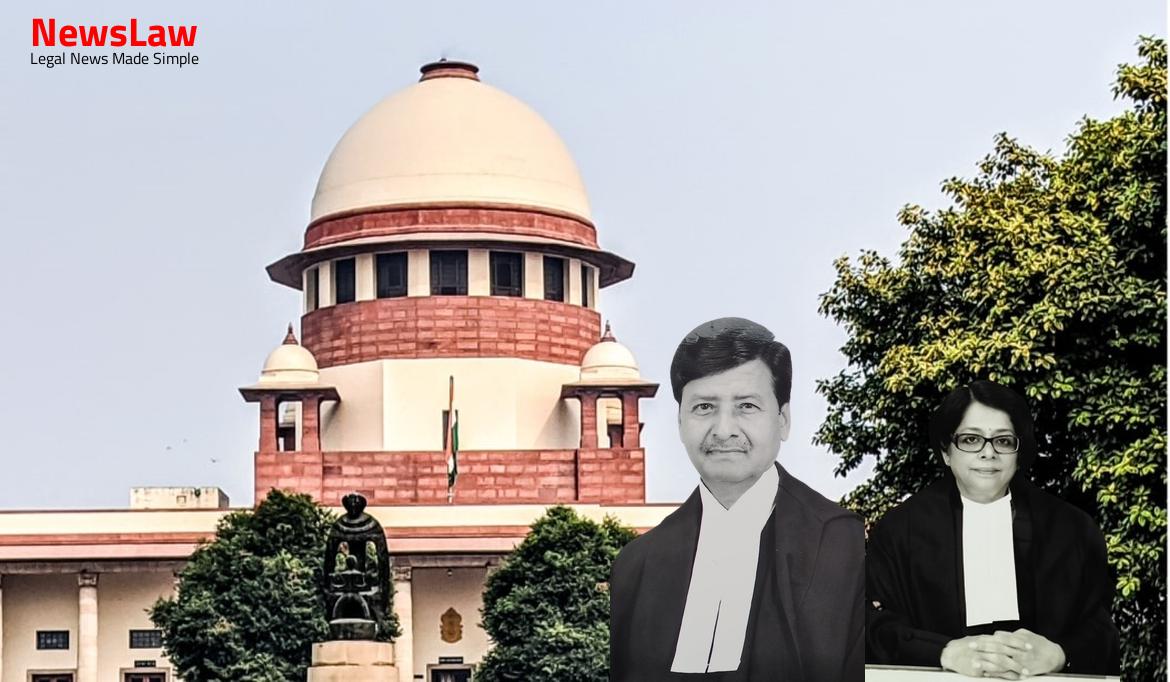This appeal is at the instance of a convict accused and is directed against the judgment and order passed by the High Court of Judicature at Madras dated 04.04.2019 in Criminal Appeal No 193 of 2019 by which the High Court dismissed the appeal filed by the appellant herein thereby affirming the judgment and order of conviction and sentence passed by the Additional Sessions Judge, Namakkal in Sessions Case No 41 of 2017. The High Court dismissed the appeal affirming the conviction of the appellant herein for the offence punishable under Section 304 Part I of the IPC. He submitted that his only endeavour is to persuade this Court to alter the conviction of the appellant from the offence punishable under Section 304 Part I of the IPC to Section 304 Part II of the IPC and reduce the sentence accordingly. At around 11 am, the deceased came at the place of the incident and threatened the driver of the lorry saying he should not drive his lorry through the pathway leading to the agriculture field of the appellant. On 25.10.2015 at 07.30 hrs Al and A2 were loading tapioca cultivated and harvested in their lands on to a lorry owned by one Mr. You may bring anyone you want” and then Al and A2 pushed the deceased Balasubramaniam down and with an intention to murder him Al had hit the head of the deceased Balasubramaniam with a “weed removing axe” (Kalaikothi) while A2 was pelting stones at him whereby the deceased Balasubramaniam sustained grievous injuries on his head.
However, PW 8 – Chidambaram and PW 9 – Jeeva are the main witnesses being the eye witnesses to the occurrence. While Subramani, Veerasamy, Raja Manikkam and Jeeva were harvesting the tubers of the person belonging to the adjacent field told us that the lorry should not move any further since he the accused have a dispute regarding the pathway in which the lorry was on. I went to pluck tapioca tubers in the garden of the accused Anbazhagan along with Chidambaram, Subramani, Veerasamy, Raja Manikkam between 07.30 & 08.00 am on 25.10.2015 at Poosari Palayam. We went inside the field with Anbazhagan to gather the tubers.
The deceased Balasubramaniam was standing on the road. At that time the accused hit the deceased at his head with the wedding axe causing injury. The details of the post- mortem examination are as follows – External injuries respectively, There was bleeding from the ear and nose, above the left eye brow 32 cm cut injury. Joseph Aristotle S., the learned counsel appearing for the respondent State on the other hand, submitted that the Trial Court as well as the High Court rightly held the appellant herein guilty of the offence punishable under Section 304 Part I of the IPC. Having heard the learned counsel appearing for the parties and having gone through the materials on record, the only question that falls for our consideration is whether the conviction of the appellant herein for the offence punishable under Section 304 Part I of the IPC should be further altered to Section 304 Part II of the IPC. As the only argument canvassed before us is that the case does not travel beyond culpable homicide as the same falls within the third part of Section 299 of the IPC, the accused could only be said to have knowledge that he is likely by his act to cause death and not the intention to kill the deceased, we must explain the fine distinction between the terms ‘intent’ and ‘knowledge’. Intention of a person cannot be proved by direct evidence but is to be deduced from the facts and circumstances of a case. They are as under:- “ The word “intent” by its etymology, seems to have metaphorical allusion to archery, and implies “aim” and thus connotes not a casual or merely possible result-foreseen perhaps as a not improbable incident, but not desired-but rather connotes the one object for which the effort is made-and thus has reference to what has been called the dominant motive, without which, the action would not have been taken.” State of Pepsu, AIR 1956 SC 488, at page 490, the following observations have been made by Chadrasekhara Aiyar J.:- “ 6. For instance, if such an act were done by a born idiot, the intent to kill could not be inferred from the act.
Bearing in mind the test suggested in the aforesaid decision and also bearing in mind that our legislature has used two different terminologies ‘intent’ and ‘knowledge’ and separate punishments are provided for an act committed with an intent to cause bodily injury which is likely to cause death and for an act committed with a knowledge that his act is likely to cause death without intent to cause such bodily injury as is likely to cause death, it would be proper to hold that ‘intent’ and ‘knowledge’ cannot be equated with each other. Once there is evidence that a deceased person, sustained injuries which were sufficient in the ordinary course of nature to cause death, the person who inflicted them could be presumed to have intended those natural and probable consequences. …
Where the evidence does not disclose that there was any intention, to cause death of the deceased but it was clear that the accused had the knowledge that their acts were likely to cause death the accused can be held guilty under the second part of sec. But the knowledge that specified consequences would result or could result by doing an act is not the same thing as the intention that such consequences should ensue. Kenny in his Outlines of Criminal Law, Seventeenth Edition at page 31 has observed:- “To intend is to have in mind a fixed purpose to reach a desired objective; the noun ‘intention’ in the present connexion is used to denote the state of mind of a man who not only foresees but also desires the possible consequences of his conduct……..
In each of these the man adopts a line of conduct with the intention of thereby attaining an end which he does desire, but at the same time realises that this conduct may also produce another result which he does not desire. For example, when under Section 299 it is said “whoever causes death by doing an act with the intention of causing death” it must be proved that the accused by doing the act, intended to bring about the particular consequence, that is, causing of death. In terms of Section 299, ‘culpable homicide’ is described as an act of causing death (i) with the intention of causing death or (ii) with the intention of causing such bodily injury as is likely to cause death, or (iii) with the knowledge that such an act is likely to cause death. As has been repeatedly held by this Court, ‘culpable homicide’ is the genus and ‘murder’ is its species and all ‘murders’ are ‘culpable homicides’ but all ‘culpable homicides’ are not ‘murders’.
Culpable homicide of this degree is punishable under the second part of Section 304.” (Emphasis supplied) 35. When a ‘culpable homicide is murder’, the punitive consequences shall follow in terms of Section 302 of the IPC, while in other cases, that is, where an offence is ‘culpable homicide not amounting to murder’, punishment would be dealt with under Section 304 of the IPC. This Court observed that the safest way of approach to the interpretation and application of these provisions seems to be to keep in focus the keywords used in the various clauses of these sections. The following comparative table will be helpful in appreciating the points of distinction between the two offences:- Section 299 Section 300 A person commits culpable homicide if the act by which the death is caused is done- Subject to certain exceptions culpable homicide is murder if the act by which the death is caused is done- INTENTION (a) with the intention of causing death; or (b) with the intention of causing such bodily injury as is likely to cause death; or (1) with the intention of causing death; or (2) with the intention of causing such bodily injury as the offender knows to be likely to cause the death of the person to whom the harm is caused; or (3) with the intention of causing bodily injury to any person and the bodily injury intended to be inflicted is suffi cient in the ordinary course of nature to cause death; or KNOWLEDGE (c) with the knowledge that the act is likely to cause death (4) with the knowledge that the act is so imminently dangerous that it must in all probability cause death or such bodily injury as is likely to cause death, and commits such act without any excuse for incurring the risk of causing death or such injury as is mentioned above.
Clause (b) of Section 299 of the IPC corresponds with clauses (2) and (3) of Section 300 of the IPC.
Also Read: https://newslaw.in/?p=548
If the assailant had no such knowledge about the disease or special frailty of the victim, nor an intention to cause death or bodily injury sufficient in the ordinary course of nature to cause death, the offence will not be murder, even if the injury which caused the death, was intentionally given. The difference between clause (b) of Section 299 of the IPC and clause (3) of Section 300 of the IPC is one of the degree of probability of death resulting from the intended bodily injury.
If such an intention to cause that particular injury is made out and if the injury is found to be sufficient in the ordinary course of nature to cause death, then clause thirdly of Section 300 of the IPC is attracted. Thirdly, it must be proved that there was an intention to inflict that particular bodily injury, that is to say, that it was not accidental or unintentional, or that some other kind of injury was intended… 18. The two matters are quite separate and distinct, though the evidence about them may sometimes overlap.” As to how the intention is to be inferred even in a case of single injury, Justice Bose further held as under:- “23. The question, so far as the intention is concerned, is not whether he intended to kill, or to inflict an injury of a particular degree of seriousness, but whether he intended to inflict the injury in question; and once the existence of the injury is proved the intention to cause it will be presumed unless the evidence or the circumstances warrant an opposite conclusion. But that is not because the prisoner did not intend the injury that he intended to inflict to be as serious as it turned out to be but because he did not intend to inflict the injury in question at all. The nature of intention must be gathered from the kind of weapon used, the part of the body hit, the amount of force employed and the circumstances attendant upon the death.” The aforesaid decision of this Court in Jagrup Singh (supra) has been strongly relied upon by the learned senior counsel appearing for the appellant. Shortly thereafter, the appellant Jagrup Singh armed with a gandhala, his brothers Billaur Singh armed with a gandasa and Jarmail Singh and Waryam Singh armed with lathies emerged suddenly and made a joint assault on the deceased Chanan Singh and the three eyewitnesses, Gurdev Singh, PW 10, Sukhdev Singh, PW 11 and Makhan Singh, PW 12.
… In our judgment, the High Court having held that it was more probable that the appellant Jagrup Singh had also attended the marriage as the collateral, but something happened on the spur of the moment which resulted in the infliction of the injury by Jagrup Singh on the person of the deceased Chanan Singh which resulted in his death, manifestly erred in applying Clause Thirdly of Section 300 of the Code. What we are trying to highlight is that in Jagrup Singh (supra), although this Court altered the conviction from Section 302 to Section 304 Part II, it took shelter of Exception 4 to Section 300 of the IPC. Therefore, for the purpose of holding an accused guilty of the offence punishable under the second part of Section 304 of the IPC, the accused need not bring his case within one of the exceptions to Section 300 of the IPC.
Undoubtedly, this Court said that there is no justification for the assertion that the giving of a solitary blow on a vital part of the body resulting in death must always necessarily reduce the offence to culpable homicide not amounting to murder punishable under Section 304, Part II of the Code. Having kept this criteria under view, we are of the opinion that the offence committed by the 1st appellant would not be covered by clause Thirdly of Para 3 of Section 300 and therefore, the conviction under Section 302, I.P.C. State of Goa [(2000) 9 SCC 1 : 2000 SCC (Cri) 1128] the accused had hit the deceased with a danda during a premeditated gang-fight, resulting in the death of the victim.
It is held in all these cases that there was no such intention to cause that particular injury as in those circumstances, the accused could have been barely aware i.e. We are concerned under clause 3rdly with the intention to cause that particular injury which is a subjective inquiry and when once such intention is established and if the intended injury is found objectively to be sufficient in the ordinary course of nature to cause death, clause 3rdly is attracted and it would be murder, unless one of the exceptions to Section 300 is attracted.
They are as under:- “The offence of culpable homicide involves the doing of an act (which term includes illegal omissions) (a) with the intention of causing death, or (b) with the intention of causing such bodily injury as is likely to cause death or (c) with the knowledge that the act is likely to cause death. 302 and the exceptions in the same section tell us when offence is not murder but culpable homicide not amounting to murder punishable under sec. The determinant factor is the intentional injury which must be sufficient to cause death, that is to say, the probability of death is not so high, the offence does not fall within murder but within culpable homicide not amounting to murder or something less. Here A is guilty of murder, although he may not have intended to cause Z’s death.’ The sufficiency of an intentional injury to cause death in the ordinary way of nature is the gist of the clause irrespective of an intention to cause death.
Two, if such causal connection between the act of the accused and the death, leads to the second stage for considering whether that act of the accused amounts to culpable homicide as defined in section 299. If this question is found in the positive but the cases come within any of the exceptions enumerated in Section 300, the offence would still be culpable homicide not amounting to murder, punishable under the first part of Section 304 of the Code. The circumstances which weighed with this Court were : (i) there was no connection between the accused and the deceased and the presence of the deceased at the time of the incident, was wholly accidental; (ii) altercation with the deceased was on the spur of the moment and the accused gave a single blow being enraged by the deceased asking him to leave the place; (iii) the requisite intention could not be attributed to the accused as there was nothing to indicate that the accused intended the blow to land on the right side of the chest which proved to be fatal. In view of the fact that the accused had given only one blow in the heat of the moment, it was held that all that can be said was that he had given the blow with the knowledge that it was likely to cause death and, therefore, the offence fell under Section 304, Part II of the IPC.
…” (Emphasis supplied)
Also Read: https://newslaw.in/?p=554
This Court altered the conviction of the appellant from Section 302 IPC to Section 304 Part II IPC and sentenced the accused to suffer rigorous imprisonment for five years. As the totality of the established facts and circumstances do show that the occurrence had happened most unexpectedly in a sudden quarrel and without premeditation during the course of which the appellant caused a solitary injury, he could not be imputed with the intention to cause death of the deceased or with the intention to cause that particular fatal injury; but he could be imputed with the knowledge that he was likely to cause an injury which was likely to cause death. Because in the absence of any positive proof that the appellant caused the death of the deceased with the intention of causing death or intentionally inflicted that particular injury which in the ordinary course of nature was sufficient to cause death, neither clause I nor clause III of Section 300 IPC will be attracted.”
Case Title: ANBAZHAGAN Vs. THE STATE REP. BY THE INSPECTOR OF POLICE (2023 INSC 632)
Case Number: Crl.A. No.-002043-002043 / 2023



